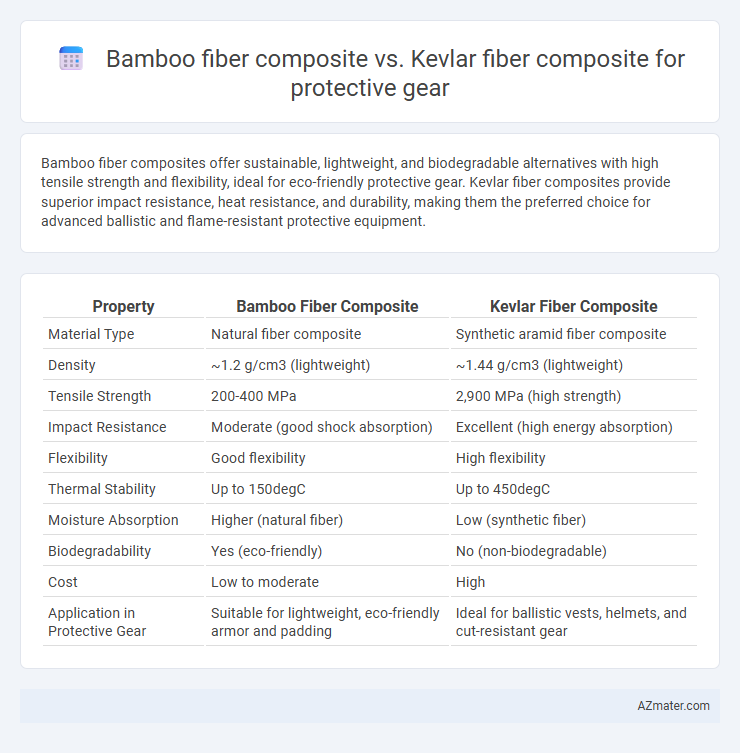Bamboo fiber composites offer sustainable, lightweight, and biodegradable alternatives with high tensile strength and flexibility, ideal for eco-friendly protective gear. Kevlar fiber composites provide superior impact resistance, heat resistance, and durability, making them the preferred choice for advanced ballistic and flame-resistant protective equipment.
Table of Comparison
| Property | Bamboo Fiber Composite | Kevlar Fiber Composite |
|---|---|---|
| Material Type | Natural fiber composite | Synthetic aramid fiber composite |
| Density | ~1.2 g/cm3 (lightweight) | ~1.44 g/cm3 (lightweight) |
| Tensile Strength | 200-400 MPa | 2,900 MPa (high strength) |
| Impact Resistance | Moderate (good shock absorption) | Excellent (high energy absorption) |
| Flexibility | Good flexibility | High flexibility |
| Thermal Stability | Up to 150degC | Up to 450degC |
| Moisture Absorption | Higher (natural fiber) | Low (synthetic fiber) |
| Biodegradability | Yes (eco-friendly) | No (non-biodegradable) |
| Cost | Low to moderate | High |
| Application in Protective Gear | Suitable for lightweight, eco-friendly armor and padding | Ideal for ballistic vests, helmets, and cut-resistant gear |
Introduction to Fiber Composites in Protective Gear
Bamboo fiber composites offer lightweight, sustainable alternatives with high tensile strength and natural impact resistance, making them suitable for eco-friendly protective gear applications. Kevlar fiber composites are renowned for exceptional tensile strength, thermal stability, and resistance to abrasion and ballistic impacts, widely used in body armor and helmets. Both materials enhance protective gear performance, balancing weight, durability, and user comfort depending on specific safety requirements.
Overview of Bamboo Fiber Composites
Bamboo fiber composites offer a sustainable and lightweight alternative for protective gear, combining natural fiber properties with enhanced mechanical strength and flexibility. These composites exhibit high tensile strength and excellent impact resistance while maintaining biodegradability and cost-effectiveness compared to synthetic fibers like Kevlar. Their natural moisture absorption and thermal insulation capabilities contribute to comfort and durability in protective applications.
Overview of Kevlar Fiber Composites
Kevlar fiber composites exhibit exceptional tensile strength, high impact resistance, and thermal stability, making them ideal for protective gear applications such as bulletproof vests and helmets. These composites combine Kevlar fibers with polymer matrices like epoxy or phenolic resins, enhancing durability and lightweight performance. Their superior energy absorption and resistance to abrasion outperform many natural fiber composites, including bamboo fiber, offering enhanced user safety in high-risk environments.
Mechanical Strength Comparison: Bamboo vs Kevlar
Bamboo fiber composites exhibit notable tensile strength and flexibility due to their natural cellulose structure, making them a sustainable alternative in protective gear applications; however, Kevlar fiber composites outperform bamboo in mechanical strength with superior tensile strength of approximately 3,620 MPa and high modulus of elasticity around 130 GPa. Kevlar's exceptional impact resistance and energy absorption capabilities provide enhanced durability and protection against ballistic threats, which bamboo composites currently cannot match. Despite this, bamboo fiber composites offer benefits in biodegradability and cost-effectiveness, yet Kevlar remains the industry standard for high-performance protective gear requiring maximum mechanical strength.
Impact Resistance and Durability
Bamboo fiber composites exhibit high impact resistance due to their natural tensile strength and flexibility, making them suitable for absorbent shock protection in protective gear. Kevlar fiber composites, known for exceptional durability and superior impact resistance, provide enhanced protection against penetration and blunt force trauma in high-performance applications. While bamboo composites offer sustainable and lightweight alternatives, Kevlar maintains a leading edge in long-term durability and resistance to extreme mechanical stress.
Environmental Sustainability and Eco-Friendliness
Bamboo fiber composites offer superior environmental sustainability compared to Kevlar fiber composites due to their renewable sourcing, biodegradability, and lower carbon footprint during production. Kevlar composites, while offering exceptional strength and durability for protective gear, rely on petroleum-based materials and generate significant waste and emissions in manufacturing. The eco-friendliness of bamboo fiber makes it a more sustainable choice for protective applications seeking to balance performance with environmental impact.
Weight and Comfort Considerations
Bamboo fiber composites exhibit significantly lower density compared to Kevlar fiber composites, resulting in lighter protective gear that reduces wearer fatigue during extended use. The natural breathability and moisture-wicking properties of bamboo fibers enhance comfort by improving ventilation and regulating temperature, unlike the relatively rigid and less breathable Kevlar fibers. These attributes make bamboo fiber composites a preferable option for applications where weight and wearer comfort are critical without compromising protective performance.
Cost-Effectiveness and Availability
Bamboo fiber composites offer significant cost-effectiveness compared to Kevlar fiber composites due to lower raw material and manufacturing expenses, making them accessible for large-scale production in protective gear applications. The abundant and renewable nature of bamboo ensures widespread availability, whereas Kevlar relies on synthetic production with higher costs and limited supply chains. Both materials provide durability and impact resistance, but bamboo fiber composites stand out for sustainable sourcing and budget-friendly protective equipment solutions.
Manufacturing Processes and Challenges
Bamboo fiber composites for protective gear involve eco-friendly, renewable materials processed through mechanical extraction and alkali treatments to improve fiber-matrix adhesion, but face challenges in achieving uniform fiber quality and moisture resistance. Kevlar fiber composites use advanced aramid fibers woven or layered with thermoset resins, demanding precise temperature and pressure control during curing to ensure optimal strength and impact resistance, though manufacturing cost and sensitivity to UV degradation remain significant hurdles. Both composites require tailored fabrication techniques to balance protective performance, durability, and scalability in production.
Future Prospects for Protective Gear Innovation
Bamboo fiber composites offer a sustainable alternative to Kevlar fiber composites in protective gear, leveraging lightweight, biodegradable, and high-tensile strength properties ideal for future eco-friendly applications. Advancements in nanotechnology and hybrid composite structures are enhancing bamboo fibers' impact resistance and durability, narrowing the performance gap with Kevlar's superior ballistic protections. Continued research into bamboo fiber treatments and matrix improvements promises scalable, cost-effective production, positioning bamboo composites as a transformative material for next-generation protective equipment.

Infographic: Bamboo fiber composite vs Kevlar fiber composite for Protective gear
 azmater.com
azmater.com